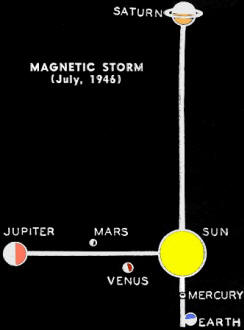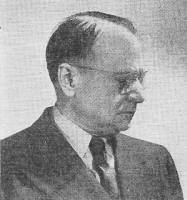|
June 1951 Radio-Electronics
 [Table of Contents] [Table of Contents]
Wax nostalgic about and learn from the history of early electronics.
See articles from Radio-Electronics,
published 1930-1988. All copyrights hereby acknowledged.
|
Syzygy is a great word for
a Scrabble game. If you use
it on a Triple Word Score (TWS) space where the "Z" sits on a Double Letter Score
(DLS) space, it will net you 105 points. About the only way to do better is to use
all 7 letters on a TWS play, where you earn 50 bonus points added to your word score
(I've done it twice in the last year). Syzygy is an astronomical term referring
to an alignment of three or more celestial bodies - not necessarily in exact alignment,
but within a few degrees. Astrologers (not to be confused with astronomers) have
since their knuckles no longer dragged on the ground exploited such scenarios to
predict various events both good and bad. That was even before they knew those "wandering"
orbs (planet means "wanderer")
were different than the (seemingly) stationary points of light. Until Galileo turned
his rudimentary telescope on the planets, the only celestial objects with a discernable
disk shape were the sun and moon, and possibly the earth. But I digress.
It was long thought that the vector sum of gravitational influences was responsible
for certain phenomena on our planet, including weather, tides, and earthquakes.
We know for a fact that one particular form of syzygy causes tidal motion (both
of the seas and of the mantle) - the sun / moon/ earth (the minimum requisite three
bodies) alignments which cause spring and neap
tides. As of this year 2020 AD,
there is no firm scientific evidence that the positions of the other planets and
their moons have any significant influence on Earth's natural processes. There is
no denying that they do have a minute, measurable influence on Earth's orbital path.
In fact, the discovery of the planet Pluto was made possible when
Percival Lowell
noted the minute perturbances of the orbit of Neptune and then calculating the possible
position of a mass that would cause such a motion, and then searching for it.
Clyde Tombaugh found
Lowell's
"Planet X," now called Pluto, in 1930.
Once radio communications researchers realized that upper atmosphere layers played
a significant role in long range transmissions, a lot of effort went into predicting
its behavior. Amateur radio operators contributed much to the science as did, of
course, professional engineers and scientists. For a while, a lot of people explored
whether or not the positions of planets influenced those ionized layers enough to
be able to foretell transmission conditions. It turns out, as you might expect,
that the sun's influence in varying the amount of charge, height above the earth's
surface, and times of occurrences in the ionized layers utterly overwhelms anything
the planets contribute. That is not to say the planet's influences are not measurable
- maybe they are - but the effects are not meaningful.
Predicting the Future of Radio Communications
 Predicting the Future from the motion of
the planets, long the basis of the ancient pseudo-science of astrology, has emerged
from the realm of superstition into the field of modern science. RCA engineer John
H. Nelson, writing in the RCA Review, reports evidence that the magnetic storms
on the earth which disrupt radio communications are directly related to the positions
of the planets. Predicting the Future from the motion of
the planets, long the basis of the ancient pseudo-science of astrology, has emerged
from the realm of superstition into the field of modern science. RCA engineer John
H. Nelson, writing in the RCA Review, reports evidence that the magnetic storms
on the earth which disrupt radio communications are directly related to the positions
of the planets.
Engineer Nelson, also an amateur astronomer, was assigned years ago to the task
of studying the spots on the sun through a 6-inch telescope set up for him on the
roof of a downtown office building in New York City. He failed to find enough correlation
between the sunspots and the behavior of radio communications to be able to make
predictions of more than a few days in advance, and in 1948 caused some comment
in astronomical circles by reporting that the size of the sunspots is a "meaningless
criterion" in predicting radio disturbances. The type of sunspots, their age and
activity, and their position on the sun are the determining factors.
Engineer Nelson turned to the planets for his research inspired by suggestions
from the late Ellsworth Huntington of Yale and Henry Helm Clayton. He studied hundreds
of daily propagation reports compiled by technicians at RCA's receiving station
at Riverhead, L. I., and from overseas stations of Radio France and Sweden's Telegraph
Administration. These he tried to correlate with the positions of the planets.
From these studies Mr. Nelson concluded that the planets disturb the sun; and
the sun in turn affects electromagnetic conditions on the earth. From daily plots
of the courses of the six inner planets he observed that disturbances on the earth
occur more frequently when two or more planets form a right angle (with the sun
as apex), or form a straight line with the sun.
The most disturbed periods are the twelve months preceding and following the
positioning of Saturn and Jupiter in such a configuration. The most severe disturbances
occur when Mars, Venus, Mercury, and Earth are in critical relationship near points
of the Saturn-Jupiter configuration. When Saturn and Jupiter have moved away from
their configuration, the earth's magnetic activity decreases, although the smaller
planets cause storms of shorter duration. The quietest periods occur when Saturn,
Jupiter, and Mars are equally spaced around the sun by 120°. The figure shows the
positions of the planets during the great 1946 magnetic storm.
Not all planetary configurations coincide with magnetic storms, but studies of
the Riverhead records show that storms are about ten times more frequent during
a configuration than on ordinary days.
Major disturbances can be predicted as much as two years in advance. By combining
planetary observations with daily inspection of the sun's surface, Mr. Nelson has
been able to predict good and bad radio weather with 85% accuracy or better.
 Also
included in the column was a the following: Also
included in the column was a the following:
Medal of Honor of the Institute of Radio Engineers was awarded
to Dr. Vladimir K. Zworykin, vice-president and technical consultant of
RCA Laboratories, Princeton, N.J. In his acceptance speech at the Institute's annual
banquet at New York's Waldorf-Astoria, Dr. Zworykin stressed the importance
of the role of electronics in the future of medicine, both in therapy and diagnosis.
Close co-operation between physician an engineer is needed to work out these problems,
he sais.
Posted May 12, 2020
|











